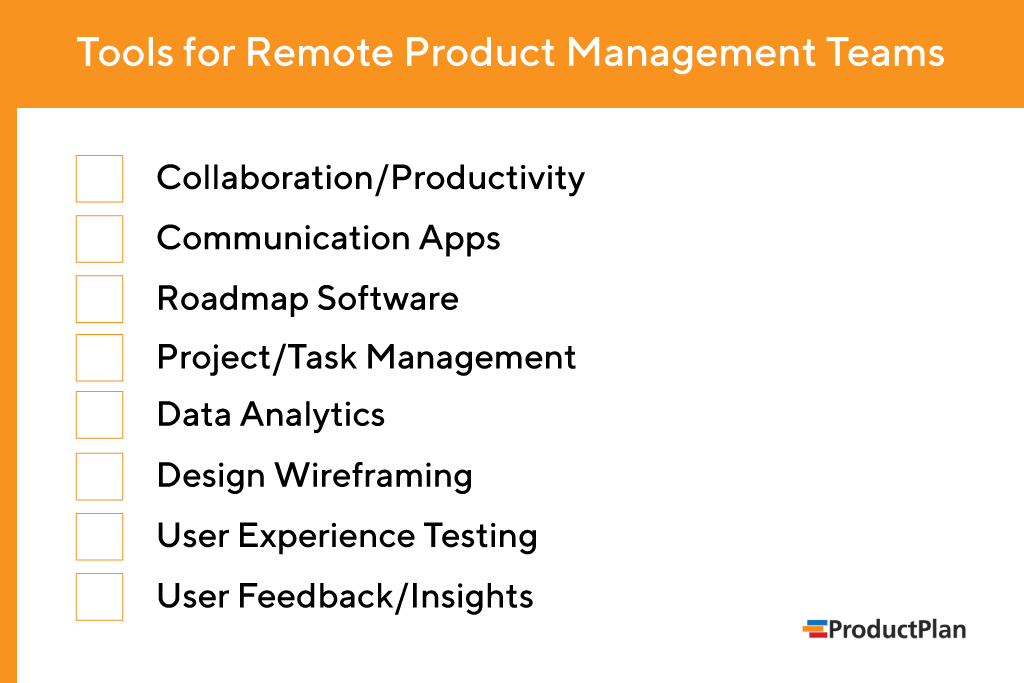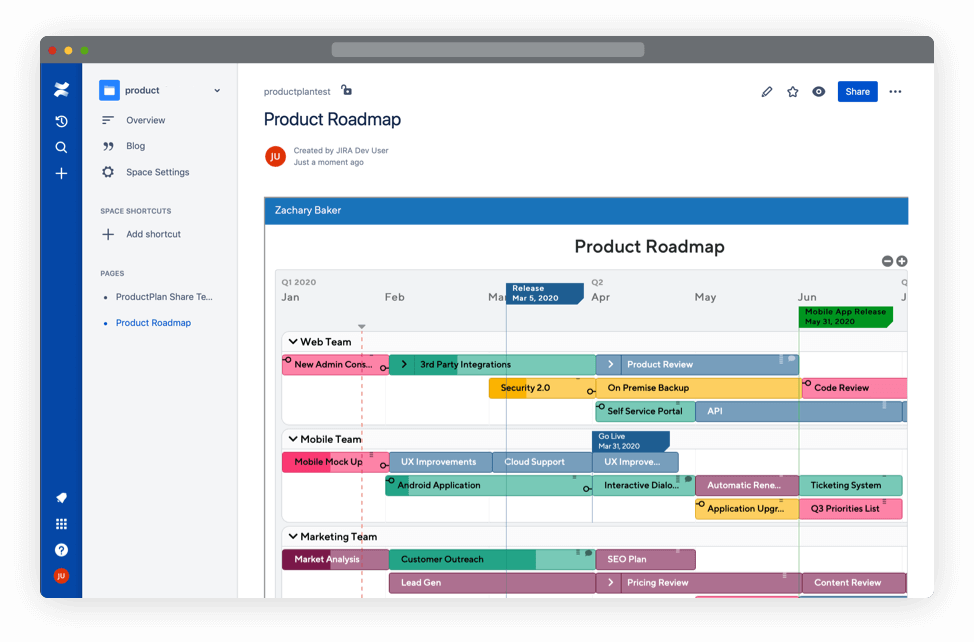With the growing remote-work trend affecting more industries than ever, product organizations increasingly find themselves managing projects with contributors in many different geographic locations. But even if their teams are scattered all over the world, product managers are still responsible for keeping those teams connected, informed, and working toward a common goal. So, in this post, we offer our thoughts on the best tools for remote product management teams.
The Best Tools for Remote Product Management Teams

Collaboration and Productivity Apps
For any modern product team to be successful, team members need a convenient and reliable online app to share and review up-to-date files and other content. This type of tool takes on even more importance when the team is working in different locations.
Email falls short here, for several reasons. Files can get lost in old email threads while version control becomes a problem as well. Unless they can see all file versions at the same time, team members won’t know whether the latest version is File_v3, File_v2-edited, or File_v1—approved.
Remote product teams need to create a single source of truth for the product’s progress. Online collaboration and productivity apps can be invaluable. A few examples:
Dropbox
Great for maintaining a single-source-of-truth version of key files such as the product backlog, sprint backlog, or a burndown chart.
Google Drive
Similar concept to Dropbox, where you can maintain all of your remote team’s key content in a single online location. Anyone on the team can access it, add comments, and check-in with these files to make sure they are still working toward the team’s strategic goals.
Confluence
A broader online collaboration app than the file-sharing tools listed above. This tool allows remote teams to monitor and update many of the details of their projects online. File sharing is just one of Confluence’s many features.
For example, remote product teams can also embed their product roadmaps right into their Confluence app. This level of transparency keeps everyone across the company up to date on product strategy.

Learn how to embed your roadmap into Confluence.
Digital Communication Tools
Reliable and convenient communication is essential for any remote product management team. Coordinating a cross-functional team working on different aspects of the product, while keeping everyone informed and motivated, is a difficult job under any conditions. But when members of the team are in different places, then communication becomes even more difficult.
That’s why remote product teams should use several different types of digital communication—such as real-time team chat and video conferencing with screen sharing. A few examples:
Slack
Sometimes a member of your product team needs an answer to a simple question. No need for a phone call or an email—just a one-line chat will do the trick. When your team uses an online messaging app like Slack, you can have these quick conversations easily, with large groups or just one-on-one.
You can even integrate roadmap updates into your Slack channels.
Zoom
Sometimes you have a meeting topic that requires more fruitful communication than an email or Slack message. If you’re presenting your roadmap to a distributed team, then a video conference with a platform like Zoom can give you more opportunity to convey strategy, to show enthusiasm, and to get a better sense of whether your team is grasping your explanation.
GoToMeeting
Here’s another great online meeting app that, like Zoom, uses the computer’s camera to allow everyone on your team to see each other during your conversation.
There are also many other great uses for video conferencing tools for a remote product management team. You can conduct virtual interviews with job candidates in other parts of the world. You can record video training sessions and demos to later show your users how to use various parts of the product.

Product Roadmap Software
As we’ve pointed out here on the ProductPlan blog before, spreadsheets and presentation slides are not the ideal way to create or share your product roadmap.
This result is partly due to the challenges we’ve discussed above, such as version control. When a roadmap saved as a spreadsheet file gets passed around the company, people quickly lose track of which version is the latest. That can lead to miscommunication and people working on the wrong things because they’re still following a strategy that your team has since changed.
ProductPlan
Web-based roadmap software is the optimal tool to create, maintain, and share a product roadmap across the company. The right app can help you:
- Create a new, visually compelling roadmap in minutes
- Share your roadmap and updates with anyone inside or outside your organization
- Quickly change display views to present different levels of detail to diverse audiences.
- Update your roadmap anywhere, using drag and drop to adjust priorities and content
- Build side-by-side comparisons of competing initiatives to prioritize the right things
- Connect your roadmap to other workflow tools
Learn more about ProductPlan’s purpose-built roadmap app.

Project and Task Management
Once a product team has discussed and aligned around a big-picture strategy, the day-to-day task-level work begins on turning that strategy to reality. But a remote product management team can’t simply walk over to its developers’ desks and ask how things are proceeding.
Online project management tools can help these distributed teams keep track of their progress across the many tasks, and milestones everyone is working on. A few examples:
Jira
An excellent tool for product owners and project managers to assign, track, and update all of the task-level responsibilities assigned to each member of the product team.
You can even connect your product roadmap to Jira.
GitHub
This online task-management app helps software development teams keep track of issues and problems that need addressing. For a remote product management team, this can be a great way of funneling bugs and other issues to developers.
Azure DevOps
Here’s another tool that’s ideal for remote product teams. Azure DevOps helps development teams manage their code’s version control, plan and track software testing plans, and even deploy their software to various test environments before publishing it live.
You can connect Azure DevOps directly into your product roadmap.
Data Analytics Apps
With growing competition in every industry, and customer expectations continuously increasing rapidly, product managers today need more than their gut instinct to make product decisions. They need data-driven business intelligence.
Which is why product management teams should be leveraging web-based data analytics applications, such as:
Google Analytics
The most well-known of the web analytics tools, Google Analytics, lets companies better understand their website traffic. Due to the many types of data Google Analytics can track—specific pages visited, time on a page; search terms entered on the site—a product team can gain a sense of what their market is and isn’t interested in.
Geckoboard
Geckoboard lets companies track and analyze their app and website activity. But this company’s key differentiator is that it turns this raw data into visual, highly intuitive dashboards—using graphical meters, charts, and large-type numbers—that anyone in the company can understand at a glance.

Design and Wireframing Tools
Products, even digital products like software, are visual. One of the challenges remote product management teams face is communicating product ideas using only words. A product manager can have difficulty articulating to a developer what the team wants a feature or tool to look like. Meanwhile, a development team might have trouble explaining the challenges of designing a sequence of screens the way the product team has requested.
To give everyone a better understanding of what the product should look like, the product management team should use apps for visual product design, prototyping, and wireframing. Some great options include:
Invision
The Invision app helps entire companies create visual representations of their entire product-design workflow. Product teams can use Invision to build wireframes, element libraries, navigation flows, and even inspiration boards for their products.
Sketch
Sketch is a design platform that businesses can use to create user flows, interactive prototypes, and to take product designs from the rough idea stage to what the app calls the Developer Handoff.
Mockplus
User Experiencing Testing
One of the most valuable tools software product teams started using in recent years—particularly agile product management teams—are usability testing apps.
These tools allow the organization to monitor how real users interact with their products. This allows the team to discover what’s resonating with users, what’s confusing them, and what aspects of the product they might not even realize are there because the team placed those features in non-intuitive places.
Some great examples of user experience testing tools include:
Hotjar
Product teams can use the Hotjar app to monitor the usage and usability of their apps and websites via heat maps, user-session recordings, conversion funnels, as well as several tools for receiving direct user feedback.
UserTesting
This app lets companies see, hear, and communicate directly with customers while they engage with the company’s product or website.
FullStory
FullStory is designed to help companies identify precisely where users have trouble engaging with their apps or websites.
User Feedback and Insights
Want to learn firsthand how real users are responding to your products? Embed tools into the products themselves that ask users to tell you.
Cloud-based app makers have made it easy and affordable for software product management teams to drop customer surveys right into their products, as well as other tools to solicit direct feedback from users while they’re interacting with the product. Gathering and analyzing this data can give a product management team the real-world insights it needs to improve its offering continually.
Pendo (Sentiments)
The Sentiments tool from Pendo lets companies create and deliver hyper-targeted surveys and polls within their applications.
UserVoice
UserVoice helps companies collect and analyze user feedback from within their apps and websites. The platform also lets a product team add a feedback tab—essentially a digital suggestion box—right into the app to solicit ideas and requests from users.
What Tools Does Your Team Use?
This is only a partial list, of course. There are certainly many other tools remote product management teams can use to keep their products on track. We list others in our blog about the product manager’s product stack. If you have other types of applications you’d like to suggest, please leave them in the comments section below. Let’s share ideas and help each other.




